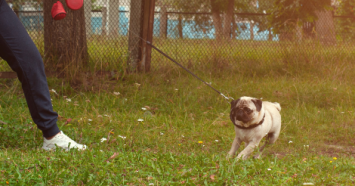
Kayden was a stray when he was rescued, likely having never had a home or much exposure to people. As a result, he’s quite shy. When he was first introduced to new people, he’d either hide in his crate or under a desk hoping no one would see him, or he’d growl or bark, warning you to leave him be.
“Skittish,” “nervous,” and “scared” were all words used to describe him. But, two years of patience and supportive training have helped get Kayden over his social anxiety. I’m not a trainer, but I can tell you the confidence boosting activities that worked well for us.
Enroll in Training
Most pet behaviorists agree that training is essential for building the confidence of insecure dogs like Kayden, and it certainly proved helpful for us. We spent several weeks in basic obedience and Canine Good Citizen classes with Kayden, teaching him practical skills like “wait” and “leave it,” as well as fun games like “high five.”
No matter the skill, helping Kayden learn what we expected of him helped boost his confidence. Classes also helped him feel more comfortable with new people and dogs in new environments. Perhaps most importantly, instilling commands like “come” were (literally) lifesavers, in case Kayden got scared and tried to flee.
Practice Passive Socialization
Bringing Kayden to the office helped him to become more social. I never asked him to do anything there, he was free to hang out under my desk. But he heard the voices of call center reps, watched the other dogs greet the UPS man, and occasionally be offered treats by co-workers.
This passive exposure helped him become more outgoing, and after a few months, he explored and found his way to other departments seeking out snacks and the best toys. He’d return to my desk if things got too overwhelming, but his willingness to make friends increased tremendously.
Look at where your dog spends most of their time at home. If they like to hunker down in a crate, consider moving the crate into a more common place in the home. We noticed that after moving his crate into the living room where he’d hear the TV, the mail man, and our other dog, Kayden became more interactive.
Go on Adventures
Normal errands for us are adventures for a shy dog. I take Kayden as often as I can when I go to the coffee shop, a ride through a drive-thru, the car wash, or a new park. Keep visits brief, try to avoid peak traffic times, always make sure your dog is safely on a leash or restraint, and give plenty of positive feedback when they do something social.
Don’t praise or reassure when they retreat or backslide. It’s best to ignore shy behavior but let them know when they’ve done something good.
Use Exercise as an Advantage
Kayden is a sporty guy who loves running, walks, swimming, and playing fetch. But Frisbee is a special game for him. The challenge of chasing down a big slobbery disc is so rewarding for him. Since he was particularly shy with men, we encouraged him to play a few games of Frisbee with the guys in the neighborhood.
Sometimes I’d even wear a hood or carry an open umbrella (triggers for him) while playing Frisbee to show him that good things happen even when these weird objects are in his presence. Whenever he has a good round of play, he’s confident, affectionate, and very attentive.
Try Overnight Visits
Just like kids overcoming homesickness after a first sleepover, dogs can overcome social anxiety through sleepovers in dog-friendly environments. Kayden occasionally spends time with co-workers, pet-sitters, or at a dog spa. Just as he built confidence in foster homes before finding us, continuous exposure to new people, pets, and places pays into his confidence bank.
Kayden is a long way from being the social butterfly we think of with most dogs, but he greets most visitors with a low wag of his tail and approaches them for a quiet ear scratch. All of his training and adventures have certainly brought him a long way from the timid dog we first knew.